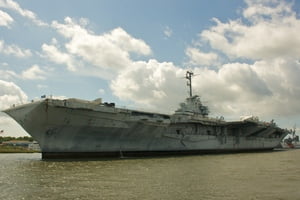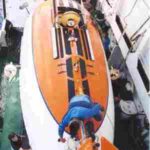Submarines can run on the surface of the water and under water and a military submarine is a warship. By definition warships carry guns and other weapons that navies use for war. Through history, navies have tried to build submarines that are both fast and able to submerge deep under water.
A submerged submarine is hard to spot from the surface allowing it to move close to enemy ships and attack them. It also allows submarines to patrol areas without being seen.
Early subs were nick named pig boats by the sailors because the air inside was stale and it stank.
The United States Navy has built and commissioned many different types of submarines and has named them after sea creatures, cities and important people. American Naval subs are classed depending on their forms or kinds of engines and each class is named after the first ship in the group.
Many submarines have long, cigar-shaped hulls (the body of a sub) and most military subs have two hulls where one fits inside the other. The hull of a submarine is stream lined to travel easily through the water.
Submarines also have hatches. These are doors that seal tightly to keep the water out. Sailors of military submarines use the hatches to look out when the sub is on the surface as military submarines do not have windows.
To see what is happening on the surface when a sub is submerged the sailors use periscopes and sonar. The sonar uses sound waves to measure depth and to locate objects underwater.
On top of most submarines there is an enclosed tower called the conning tower. This tower has two vents through which air enters and smoke or fumes escape. The vent through which air enters is called the snort and the vent that allows smoke and fumes to escape is called the exhaust. The conning tower also contains the submarine’s periscopes and radar antennas.
Military submarines usually have two decks where the sailors live and work with the control room being the most important compartment on the ship.
To make the submarine submerge sailors add ballast to it and to make it rise they reduce the ballast. This is all done through opening and closing valves on the ballast tanks.
Submarines use diving planes to help them steer. A diving plane is a metal plate that tilts a sub up and down and they are located at the bow and the stern of a sub. Submarines also have rudders, which helps the sub to steer left and right. Many military submarines have fuel-powered engines and battery powered electric motors.
Some modern submarines have nuclear powered engines that last longer than other kinds of energy. Nuclear fuel comes in the form of rods.
The speed of submarines is measured in knots. One knot is 1.15 miles per hour. The fastest navy subs have top speeds of 50 knots, which is about 58 miles per hour. It was during the 1950’s that better streamlining and engine design made it possible for submarines to travel distances more quickly underwater.
A submarine’s most important weapons used to be its torpedoes and today, subs still carry improved kinds of torpedoes. They also had ant-aircraft guns on their conning towers. Since the 1950’s, guided missiles have been the most important weapon on a sub. These missiles are guided by radar to its target and some of these missiles have ranges up to 8,000 miles.
Submarines have been around for a long time and the first submarine was made by Cornelius Drebbel in 1620. His submarine was a 12-person rowboat covered with oilskin (leather soaked in oil to make it waterproof). Sailors rowed the submarine but Drebbel’s submarine could not move very fast or dive very deep.
Inventor David Bushnell built the first military submarine in 1775 and he named his sub the Turtle. It was made of wood and shaped like an egg. The turtle could only hold one sailor and could not dive deep. Bushnell made the submarine to help colonists fight the British during the Revolutionary War of 1775-1783.
The first submarine to sink a ship was during the Civil War of 1861-1865. In 1864, a Confederate Navy submarine called the Hunley sank a Union warship.
In 1898,another inventor, John Holland, built the first submarine that was powered by gasoline engines and batteries. This sub was name the Holland after its inventor. The navy bought the Holland in 1900 making it the first ever Navy submarine. Unfortunately the Holland gave off fumes that stank and often poisoned her crew.
It was during World War 1 (1914-1918) that the German Navy became the first Navy to use diesel-powered submarines in battle. These were called U-boats and in 1914 a U-boat sank three British warships.
Although the U.S. Navy didn’t use submarines much during the First World War they were impressed by how well the U-boats worked and throughout the 1930’s the U.S. navy built and tested many new submarines. These all had diesel engines and battery-powered electric motors.
During World War II the U.S. Navy submarines helped fight battles with Japan. 300 U.S. submarines were used during this war and they sank 1,178 Japanese supply ships and 214 Japanese warships. The Japanese destroyed only 52 U.S. Navy subs.
After World- War II the U.S. Navy wanted new submarines and sold many of its old subs to its allies. The Navy then went about streamlining its subs by removing their deck guns and anti-aircraft guns. This had a positive effect on the speed of a sub and since 1954 the navy has put nuclear-powered engines in its submarines that allow subs to dive to a deeper level and refuel less often.
Nuclear-powered submarines have been able to dive as deep as 2,300 feet and many of today’s submarines can stay submerged for months, as they only need refueling every 15 years.
Since the 1960’s the navy has built new types of missile-armed subs with each new class being bigger and more powerful than the last. The Navy also has attack submarines that were commissioned to do battle with enemy submarines. These submarines are armed with torpedoes and short-range missiles.
Source Submarines by Michael Green




